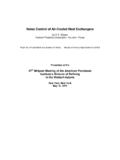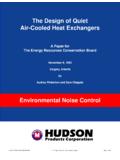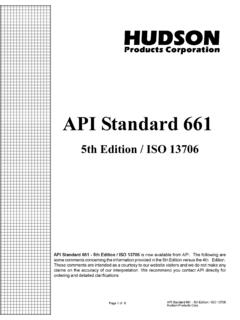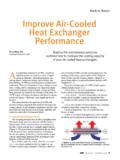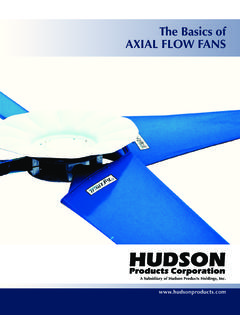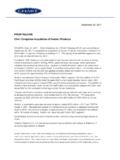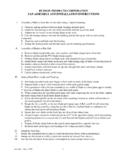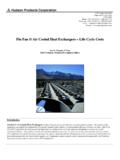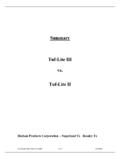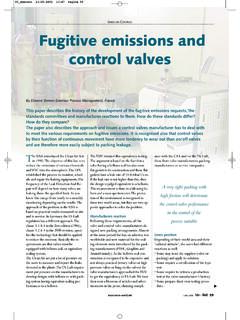Transcription of Consider Variable Pitch Fans - Hudson Products
1 Consider Variable Pitch fans by Monroe Hudson Products Corporation, Houston, Texas Based on material originally presented at the 19th ASME-AIChe Heat Transfer Conference, Orlando, Florida Consider Variable Pitch fans use in the USA. Its advantage is that critical components are accessible for easy adjustment or maintenance from the walkway. By R. C. Monroe Fig. 3 shows the electrically operated hub for a 28 ft. Presented is a detailed analysis of the control and ( ) diameter fan that will be used in a large air energy saving advantages of Variable Pitch fans . cooled steam condenser. The thrust bearing above Basic mechanical and operating principles are the gear box is lubricated by the gear box oil pump. also covered. Operating and Control Characteristics Monroe, Hudson Products Company, Houston Variable Pitch fan operators used in air coolers can be described in general terms as very similar to Variable Pitch fans provide the precise amount of diaphragm operated, spring return valves.
2 Instead of airflow to control process temperature and save moving a valve stem up and down the operator substantial amounts of energy at the same time .. controls fan blade Pitch . A force diagram is shown in automatically. This article discusses their ability to Fig. 4. control, to conserve energy, and their basic operating characteristics and mechanical aspects. As the blade moves the air, the aerodynamic Economic comparisons with other type air flow moment (CW) tries to feather the blade. The hub control systems for axial fans are made. spring creates an opposing moment (CCW) to make the blade do work. This is a fail-safe mechanism so Auto- Variable , controllable Pitch , or Variable Pitch that if the air pressure on the diaphragm fails, the fan are words usually used to describe axial fans with operates as a fixed Pitch fan providing design air blades that change Pitch in operation, so that the flow.
3 fans can be assembled to move to maximum precise amount of airflow is furnished to meet the or minimum air flow on loss of air signal. The initial requirements for a particular heat exchanger or spring preload has to be sufficient to keep the blade cooling tower. from feathering. In the years of low cost energy, the impetus to use To reduce the air flow, or even reverse the air flow Variable Pitch fans has been for precise temperature direction, air pressure is exerted on the diaphragm to control, generally to within four percent or less of oppose the hub spring and decrease blade Pitch . the set point. However there is new interest in Variable Pitch fans for the energy saving potential as When the blade Pitch is about minus 10 , no work is well. done and essentially "zero" flow is attained.
4 Minimum air velocity obtainable is approximately This article will discuss characteristics of Variable 50-100 fpm (. ). If the hub has its Pitch Pitch fans under 30 feet ( in) in diameter and less stops adjusted for reverse flow, the air is directed than 150 horsepower (112 Kw). The most typical downward and can be as much as about 60 percent sizes would be 10 to 14 feet ( ) in diameter of the upward flow at the same horsepower. The consuming up to 40 horsepower (30 Kw). Shown in decrease in flow capability is because of poor Fig. 1 through 3 are several different types of efficiency in the reverse Pitch mode. Variable Pitch fans . Fig. 1 shows the typical type found in air coolers. Fig. 2 shows an inverted A typical Variable Pitch hub requires a 3-15 psi actuator type popular in Europe but not in general (21103 kPa) control signal and operates the blades Hudson Products Corporation Page 2 of 13.
5 Houston, Texas Consider Variable Pitch fans from some maximum Pitch down to "zero" air flow. It typically fails to maximum flow if the control The valve positioner receives the control air signal signal is interrupted but can be made to fail to and outputs a higher modulated air pressure to the minimum or negative flow. Most hubs are capable of diaphragm which moves the fan blades to their 45 total Pitch travel and perform as shown in Fig. 5. proper position to satisfy the air flow requirements as called for by the temperature controller. For a 3. Fig. 6 shows the actual results of two full scale tests: to 15 psi (21 - 103 kPa) control signal the output One of a 7 ft. ( m) diameter fan with 10 pressure of the valve positioner might be 7 to 23 psi horsepower installed and another of a 24 ft.
6 ( m) (48-159 kPa) to make the fan blades move to their diameter fan with 125 hp (93 Kw) installed. The required Pitch angle. common shape of the curves can easily be seen. Note that the equivalent control signal for the The advantage of the valve positioner is precise air electric operator is 4-20 ma compared to 3-15 psi flow control due to the feedback of blade Pitch (21-103 kPa) for pneumatically controlled fans . position and the ability to output high pressure on the diaphragm to quickly attain that position. Typical components. A typical fan hub mechanism is shown in Fig. 7. The basic components of a hub If air flow control is not critical, an "open loop". are: system can be used. The simplest would operate the fan using the 3-15 psi (21-103 kPa) signal alone.
7 It Hub spring is an "open loop" system in that an air signal is Diaphragm imposed on the diaphragm and the proper Pitch Piston angle is assumed to be attained. This will be no Blade shafts with eccentric actuator problem for coolers or units that are not sensitive to Rotary air joint air flow and where 15 psi (103 kPa) diaphragm Valve positioner pressure is sufficient to move the blades through their required Pitch travel. Operation with only 3-15. The blade shafts or axles hold the fan blade and have psi is generally limited to small fans . an eccentric bearing on the inboard end. These eccentrics engage the groove in the piston. As the An alternate device called a bias relay can operate piston moves up or down a twisting motion is most fans in lieu of a valve positioner.
8 It is very imparted to the blades, changing Pitch . The rotary simple, less expensive and requires no maintenance. air joint is the static/dynamic interface between the It is mounted in the "cold" air outside the fan ring. rotating fan and its control air system. A bias relay operates by receiving the control signal, Methods of control. The valve positioner is a adding or subtracting a constant pressure and "closed loop" feedback device which receives the multiplying the sum by a fixed gain. It outputs a control signal, (usually 3-15 psi) and supply pressure modulated higher pressure to simulate the output of up to 100 psi (689 kPa), receives feedback as to the the valve positioner. The bias relay has to be set for blade position and adjusts the diaphragm pressure to a particular fan application to provide diaphragm satisfy the control signal.
9 Valve positioners are used pressure proportional to the instrument pressure to when air flow is critical, as for condensers. make the blades move through their desired Pitch travel (Fig. 8). Control signals can be "split-ranged" to actuate the fan control using only 3-9 psi (21-62 kPa), or from Bias relays can provide the proper starting point so 9-15 psi (62-103 kPa) signal pressure. the blades begin decreasing Pitch at 3 psi (21. Hudson Products Corporation Page 3 of 13. Houston, Texas Consider Variable Pitch fans kPa), but with a fixed multiplier or gain (usually 2 or 3), they usually cannot provide the output pressures Of the methods of control, the oldest is probably the to assure an exact 12 psi (83 kPa) span. bypass method. This is merely bypassing the throughput if the air cooler is overcooling.
10 Hysteresis. Another point of interest is shown in Fig. 8. Note that there is a difference in the Pitch "On-off" fan control is simple and is often used if angle versus diaphragm pressure for increasing and there are a large number of fans in an identical decreasing pressure. This is because of hysteresis in service. This non-modulating control method, the hub operating mechanism caused by friction. however, can cause problems in air cooled Hysteresis is practically nil when a positioner is used condensers such as water hammer or tube to header and even if it is present and there is a slight leakage with differential expansion of bundles in discrepancy in air flow to control the process parallel. Differential tube expansion can cause tube temperature, the (Temperature Indicating buckling.)
